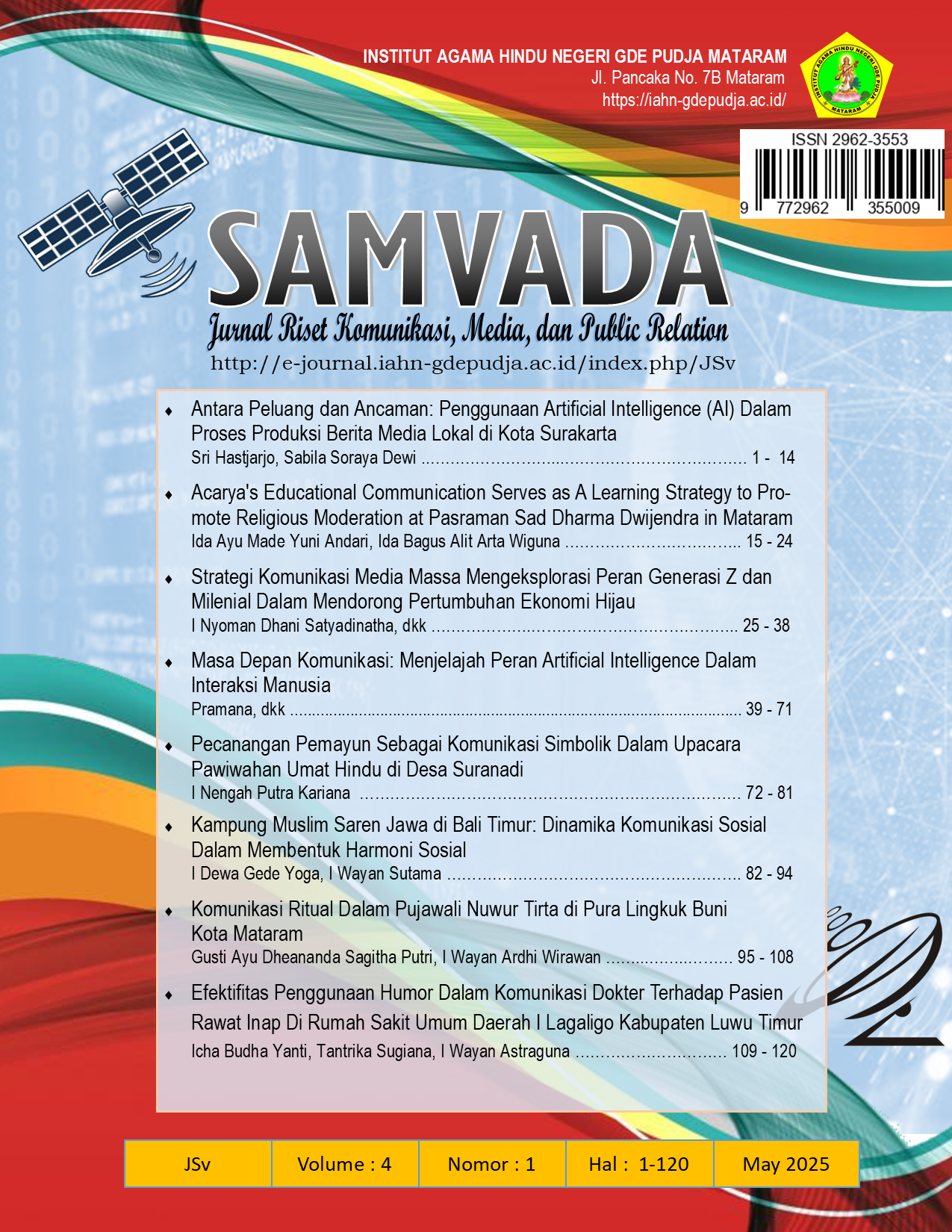KAMPUNG MUSLIM SAREN JAWA DI BALI TIMUR: DINAMIKA KOMUNIKASI SOSIAL DALAM MEMBENTUK HARMONI SOSIAL
Abstract
Kampung Saren Jawa is a unique example of how different cultural and religious identities can coexist in a multicultural society. This study aims to understand how social interaction, communication between individuals, and the influence of cultural and religious values in creating social harmony amidst the diversity of Bali which is better known for its Hindu majority. Qualitative research methods were used with a qualitative descriptive approach involving in-depth interviews with village residents, religious leaders, and local government representatives. The results of the study show that social communication in Kampung Saren Jawa is strongly influenced by the values of friendship, tolerance, and mutual respect between individuals. Despite religious and cultural differences, openness in communication and strengthening social ties based on mutual cooperation and local traditions play an important role in maintaining harmony. The role of community leaders, both from religious and customary circles, is also crucial in mediating differences and building mutual respect. These findings provide important insights for the study of social communication and interfaith interaction in a multicultural context, as well as its relevance in strengthening social cohesion in Indonesia, especially in areas with high ethnic and religious diversity.
References
Atmadja, N. B. (2017). Genealogi Keruntuhan Majapahit. Yogyakarta:Pustaka Pelajar.
Edy Sumaryanto, & Malik Ibrahim. (2023). KOMUNIKASI ANTAR BUDAYA DALAM BINGKAI TEORI-TEORI ADAPTASI. Nusantara Hasana Journal, 3(2), 42–51. https://doi.org/10.59003/nhj.v3i2.895
Gärtner, C., Konz, B., & Hans, A. (2022). Art as a Medium in Heterogeneous Learning Groups: First Findings of an Empirical Study. Religions, 14(1), 17. https://doi.org/10.3390/rel14010017
Gunada, I. W. A., & Sutajaya, I. M. (2023). PENDIDIKAN AGAMA HINDU PADA PAUD DAN INTERNALISASI MODERASI BERAGAMA DALAM PERSPEKTIF TRI HITA KARANA. Kumarottama: Jurnal Pendidikan Anak Usia Dini, 2(2), 167–180. https://doi.org/10.53977/kumarottama.v2i2.801
Julianingsih P., L. E. M., & Widana, I. N. M. (2022). KONSTRUKSI KERUKUNAN BERAGAMA PADA PLURALITAS MASYARAKAT DUSUN KERANING DALAM PENGARUSUTAMAAN MODERASI BERAGAMA. Widya Sandhi Jurnal Kajian Agama Sosial Dan Budaya, 13(2), 85–110. https://doi.org/10.53977/ws.v13i2.791
Kim, Y. Y. (2001). Becoming Intercultural: An Integrative Theory of Communication and Cross-Cultural Adaptation. SAGE Publications, Inc. https://doi.org/10.4135/9781452233253
Kim, Y. Y. (2017). Cross-Cultural Adaptation. In Oxford Research Encyclopedia of Communication. Oxford University Press. https://doi.org/10.1093/acrefore/9780190228613.013.21
Low, S. (2016). Staging a Gay Past in the Present: An Interview with The Gay Heritage Project Collaborators Damien Atkins, Paul Dunn, and Andrew Kushnir. Canadian Theatre Review, 166, 98–100. https://doi.org/10.3138/ctr.166.018
Marontate, J. (2005). Rethinking Permanence and Change in Contemporary Cultural Preservation Strategies. The Journal of Arts Management, Law, and Society, 34(4), 285–305. https://doi.org/10.3200/JAML.34.4.285-305
Mashad, D. (2014). Muslim Bali Mencari Kembali Harmoni yang Hilang. Jakarta: Pustaka Al-Kautsar.
Niswatin. (2016). Nilai Kearifan Lokal “Subak” Sebagai Modal Sosial Transmigran Etnis Bali. Jurnal Akuntansi Multiparadigma, 6, 171–188. https://doi.org/10.18202/jamal.2016.08.7015
O’Connell, M. H. (2014). The Dance of Open Minds and Hearts. Political Theology, 15(1), 74–87. https://doi.org/10.1179/1462317X13Z.00000000063
Pageh, I. M. (2013). Model Integrasi Masyarakat Multietnik Nyama Bali-Nyama Selam Belajar Dari Enclaves Muslim di Bali. Denpasar: Putaka Larasan.
Pajarianto, H., Pribadi, I., & Sari, P. (2022). Tolerance between religions through the role of local wisdom and religious moderation. HTS Teologiese Studies / Theological Studies, 78(4). https://doi.org/10.4102/hts.v78i4.7043
Parimartha, I. G. (2012). Bulan Sabit di Pulau Dewata Jejak Kampung Islam Kusamba-Bali.
Putera, G. N. K. (2024). PENGUATAN NILAI-NILAI MODERASI BERAGAMA MELALUI PENDIDIKAN PASRAMAN NONFORMAL. Padma Sari: Jurnal Ilmu Pendidikan, 4(01), 25–31. https://doi.org/10.53977/ps.v4i01.1940
Rinaldi Permana Putra. (2023). Awal Penyebaran dan Perkembangan Agama Islam di Pulau Bali. Jurnal Keislaman, 6(1), 41–49. https://doi.org/10.54298/jk.v6i1.3622
Rudiarta, I. W. (2023). Pengembangan Potensi Seni Siswa Melalui Pembelajaran Di Pasraman. Widya Sundaram : Jurnal Pendidikan Seni Dan Budaya, 1(02), 168–187. https://doi.org/10.53977/jws.v1i02.1293
Stewart, E. C., & Bennett, M. J. (1991). American Cultural Patterns A Cross-Cultural Perspective (2nd ed.). Intercultural Press, inc.
Sumbulah, U. (2012). Islam Jawa dan Akulturasi Budaya: karakteristik, Variasi dan ketaatan ekspresif. El-HARAKAH (TERAKREDITASI). https://doi.org/10.18860/el.v0i0.2191
Suparta, I. M., & Kardana, I. N. (2017). Pemakaian Bahasa Oleh Masyarakat Bugis Di Desa Senganan, Tabanan, Bali. KULTURISTIK: Jurnal Bahasa Dan Budaya, 1(1), 21. https://doi.org/10.22225/kulturistik.1.1.214
Vadrucci, M. (2025). Sustainable Cultural Heritage Conservation: A Challenge and an Opportunity for the Future. Sustainability, 17(2), 584. https://doi.org/10.3390/su17020584
Wirdiata, I. M. S., & Sutama, I. W. (2023). Komunikasi dan Perubahan Sosial dalam Tradisi Pasidikaran Masyarakat Hindu Lombok. Samvada : Jurnal Riset Komunikasi, Media, Dan Public Relation, 2(1).
Yantos, Y., & Putriana, P. (2021). Kearifan Lokal Dalam Membangun Kerukunan Islam Dan Hindu di Desa Adat Kuta Badung. Jurnal Dakwah Risalah, 31(2), 237. https://doi.org/10.24014/jdr.v31i2.10398



1.png)







